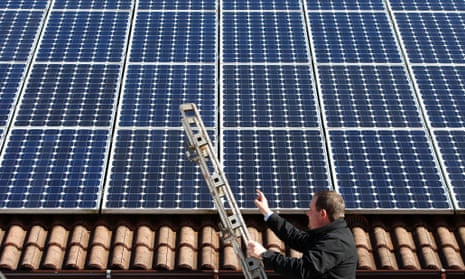Ten million homes in the UK should have their roofs covered with solar panels in the next six years, if the country is to fulfil its renewable energy potential, energy experts said on Wednesday.
That number - of more than a third of households generating energy from the sun - would allow the UK to produce about 6% of its annual electricity needs from solar power, with as much as 40% coming from the panels on sunny days in summer, by 2020. These figures are comparable to those of Germany, which has made a major push on solar power in the last decade.
Installing more solar panels brings the costs of the technology down dramatically, because of economies of scale, as the example of Germany and other countries shows. By 2030, the cost of solar should be comparable to that of even the dirtiest forms of coal, and of gas, said Ajay Gambhir, of Imperial College London.
Nearly half a million homes in the UK have solar panels installed today, recent figures show.

At present, the cost of solar power in Germany is about Euro cents 10 per kilowatt hour, compared with about 6 to 8 Euro cents per kilowatt hour for “brown” coal – the most carbon-intensive form of the fuel, but also the cheapest – and gas. On current trends that should reduce to 6 to 8 Euro cents per kilowatt hour for solar energy by 2030, while the cost of fossil fuels is expected to stay the same, according to academics from the Grantham Institute at Imperial College London, who published a briefing paper on the subject on Wednesday.
But these aspirations will only be met in the UK if the government spearheads a move to install more solar panels, not just on houses but also on large public buildings and offices, and through the building of “solar farms”, in which large arrays of panels cover fields.
Germany has managed to incorporate renewable power from sun and wind into its energy mix successfully, thanks in part to the government’s decision in 2011 after the Fukushima nuclear incident to pursue an “energiewende” – a nationwide energy transformation – to remove nuclear power and concentrate more resources on renewable energy.
The UK would face more serious challenges, said the researchers from Imperial College London’s Grantham Institute, as the incorporation of renewable energy into the electricity grid has so far been slow.
Many of the UK’s current coal-fired power stations and ageing nuclear reactors will have to be taken out of service by the end of the decade, but efforts to replace this generation with renewable power have so far progressed slowly.
The government began to row back on its commitment on subsidies to households with solar panels in 2011, scaling down dramatically the 'feed-in tariff' payments available, which created turmoil in the market. The prime minister, David Cameron, is alleged last year to have railed against the “green crap” in energy bills, by which he is understood to have meant charges for the roll-out of energy efficiency as well as subsidies for renewables.
Solar energy could be in for a massive expansion in the UK, according to the research from the Grantham Institute, but this would require favourable policies to encourage the installation of millions more panels on rooftops across Britain. Modern photovoltaic panels can generate energy even in cloudy conditions, though they perform better when it is bright.
In recent weeks, the main focus of government energy generation policy has been shale gas, which the prime minister spoke out for in Davos, the annual meeting of the rich and powerful. Ministers have argued that shale gas exploration could be a major source of indigenous energy.

Comments (…)
Sign in or create your Guardian account to join the discussion